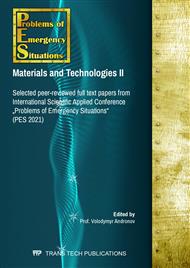p.162
p.168
p.177
p.185
p.193
p.203
p.210
p.221
p.235
Influence of Basic Oxides Ratio Li2O/Al2O3, SiO2/Al2O3 and H2O/Al2O3 on Physical, Rheological and Colloidal-Chemical Properties of Lithium Containing Alumosilicate Suspensions in the System xLi2O-Al2O3-nSiO2-mH2O
Abstract:
The influence of the main structure-forming oxides Li2O/Al2O3, SiO2/Al2O3 and H2O/Al2O3 on the physical, rheological and colloidal-chemical properties of lithium-containing alumosilicate suspensions xLi2O-Al2O3-nSiO2-mH2O in the system are presented for the first time. As a result of optimization, the optimal area of influence of variable factors was determined for the ratio of oxides Li2O/Al2O3 from 0.82 to 1.05 mol, SiO2/Al2O3 from 3.4 to 4.5 mol and H2O/Al2O3 from 19 to 21.5 mol, providing normative levels of properties of lithium-containing alumosilicate suspensions, namely: density from 1.4 to 1.521 g/cm3, process viscosity from 15 to 47 sec, pH from 11.15 to 11.34, surface tension from 51.4 to 60.4 mN/m, cosine of the substrate contact angle from 0, 57 to 0.91, work of adhesion forces from 97 to 116 mN/m, work of cohesion forces from 103 to 121 mN/m, work of wetting forces from 27 to 52 mN/m, wetting coefficient from 0.78 to 0.96, spreading coefficient from –5 to –20 mN/m. The data obtained will form the basis for the creation of protective materials of new generation that, in the event of emergencies, can provide both the protection of people and technological equipment, buildings and constructions.
Info:
Periodical:
Pages:
193-202
Citation:
Online since:
July 2021
Authors:
Price:
Сopyright:
© 2021 Trans Tech Publications Ltd. All Rights Reserved
Share:
Citation:


